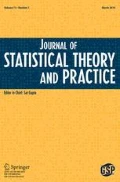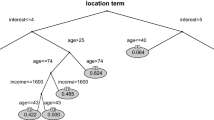Abstract
Recursive path analysis is a useful tool for inference on a sequence of three or more response variables in which the causal effects of variables, if any, are in one direction. The primary objective in such analysis is to decompose the total effect of each variable into its direct and indirect components. Methods for recursive analysis of a chain of continuous variables are well developed but there is a lack of uniform methodology when the variables are categorical. In this paper we propose an approach for categorical response variables that is based on generalized linear models. The proposed method has the flexibility of allowing the use of common categorical data models such as the Poisson, Probit and logistic regression models, along with definitions of direct and indirect effects in terms of relative risks and odds ratios. The method can be implemented easily using standard statistical software such as the GENMOD procedure of SAS. This proposed method is illustrated using real data.
Similar content being viewed by others
References
Agresti, A., 1990. Categorical Data Analysis. John Wiley, New York.
Asher, H. B., 1976. Causal Modelling. Sage Publications, Thousand Oaks.
Duncan, O. D., 1966. Path analysis: sociology examples. American Journal of Sociology, 72, 1–16.
Duncan, O. D., 1975. Introduction to Structural Equation Models. Academic Press, New York.
Eshima, N., Tabata, M., Zhi, G., 2001. Path analysis with logistic regression models: effect analysis of fully recursive causal systems of categorical variables. Journal of the Japanese Statistical Society, 31, 1–14.
Goldberger, A. S., 1972. Structural equation models in the social sciences. Econometrika, 40, 979–1001.
Goodman, L. A., 1973a. The analysis of multidimensional contingency tables when some variables are posterioe to others: a modified path analysis approach. Biometrika, 60, 179–192.
Goodman, L. A., 1973b. Causal analysis of data from panel studies and other kinds of surveys. American Journal of Sociology, 78, 1135–1191.
Hagenaars, J. A., 1990. Categorical Longitudinal Data. Sage Publications, New York.
Hagenaars, J. A., 1993. Loglinear Models with Latent Variables. Sage Publications, New York.
Hagenaars, J. A., 1994. Latent variables in log-linear models. In: Eye, A. V., Clogg, C. C. (editor), Latent Variables Analysis, pp. 329–352, Thousand Oaks. Sage Publications.
Hagenaars, J. A., 1998. Categorical causal modeling: latent class analysis and directed log-linear models with latent variables. Sociological Methods and Research, 26, 436–486.
Hagenaars, J. A., 2002. Directed loglinear modeling with latent variables: causal models for categorical data with nonsystematic and systematic measurement errors. In: Hagenaars, J. A., McCutcheon, A. L. (editor), Applied Latent Class Analysis, pp. 234–286, Cambridge. Cambridge University Press.
Hoyle, R. H., 1995. Structural Equation Modeling Approach: Basic Concepts and Fundamental Issues. In: Hoyle, R. H. (editor), Structural Equation Modeling, Concepts, Issues and Applications, pp. 1–15. Sage Publications, Thousand Oaks.
Johnson, P. L., 2001. Nonlinear Path Models with Continuous or Dichotomous Variables. PhD thesis, University of Florida.
Joreskog, K. C., Sorbom, D., 1989. LISREL 7 User’s Reference Guide. SPSS Inc., Chicago.
Land, K. C., 1969. Principles of path analysis. Sociological Methodology, 1, 3–37.
Maruyama, J. M., 1998. Basics of Structural Equation Modeling. Sage Publications, Thousand Oaks.
McCullagh, P., Nelder, J. A., 1989. Generalized Linear Models, 2nd Ed. Chapman & Hall/CRC, Boca Raton.
Pearl, J., 1995. Causal diagrams for empirical research. Biometrika, 82, 669–710.
Pearl, J., 2000. Causality: Models, Reasoning and Inference. Cambridge University Press, New York.
Pearl, J., 2001. Direct and indirect effects. In: Kaufmann, M. (editor), Seventeenth Conference on Uncertainty in Artificial Intelligence, pp. 411–420, San Francisco, CA.
Robins, J. M., 2003. Semantics of causal dag models and the identification of direct and indirect effects. In: Green, P., Hjort, N. L., Richardson, S. (editor), Highly Structured Stochastic Systems, pp. 70–81. Oxford University Press, New York.
Robins, J. M., Greenland, S., 1992. Identifiability and exchangeability for direct and indirect effects. Epidemiology, 3, 143–155.
Rubin, D. B., 2004. Direct and indirect causal effects via potential outcomes. Scandinavian Journal of Statistics, 31, 161–171.
Spirtes, P. C., Glymour, C. N., Scheines, R., 2000. Causation, Prediction and Search. MIT Press, Boston MA, 2nd edition.
Van der Laan, M. J., Petersen, M. L., 2004. Estimation of direct and indirect causal effects in longitudinal studies. In: U. C. Berkeley, Division of Biostatistics Working Paper 155, pp. 1–27. The Berkeley Electronic Press, Berkeley.
Vermunt, J. K., 1996. Causal log-linear modeling with latent variables and missing data. In Engel, U., Reincke, J. (editor), Analysis of Change: Advanced Techniques in Panel Data Analysis.
Wilson, T. P., Bielby, W. T., 1983. Recursive models for categorical data. Social Science Research, 12, 109–130.
Wright, S., 1934. The method of path coefficients. Annals of Mathematical Statistics, 5, 161–215.
Wright, S., 1960. Path coefficients and path regressions: Alternative or complementary concepts? Biometrics, 16, 189–202.
Author information
Authors and Affiliations
Corresponding author
Rights and permissions
About this article
Cite this article
Rao, P.V., Li, H. & Roth, J. Recursive Path Models when Both Predictor and Response Variables are Categorical. J Stat Theory Pract 2, 663–676 (2008). https://doi.org/10.1080/15598608.2008.10411901
Received:
Revised:
Published:
Issue Date:
DOI: https://doi.org/10.1080/15598608.2008.10411901




